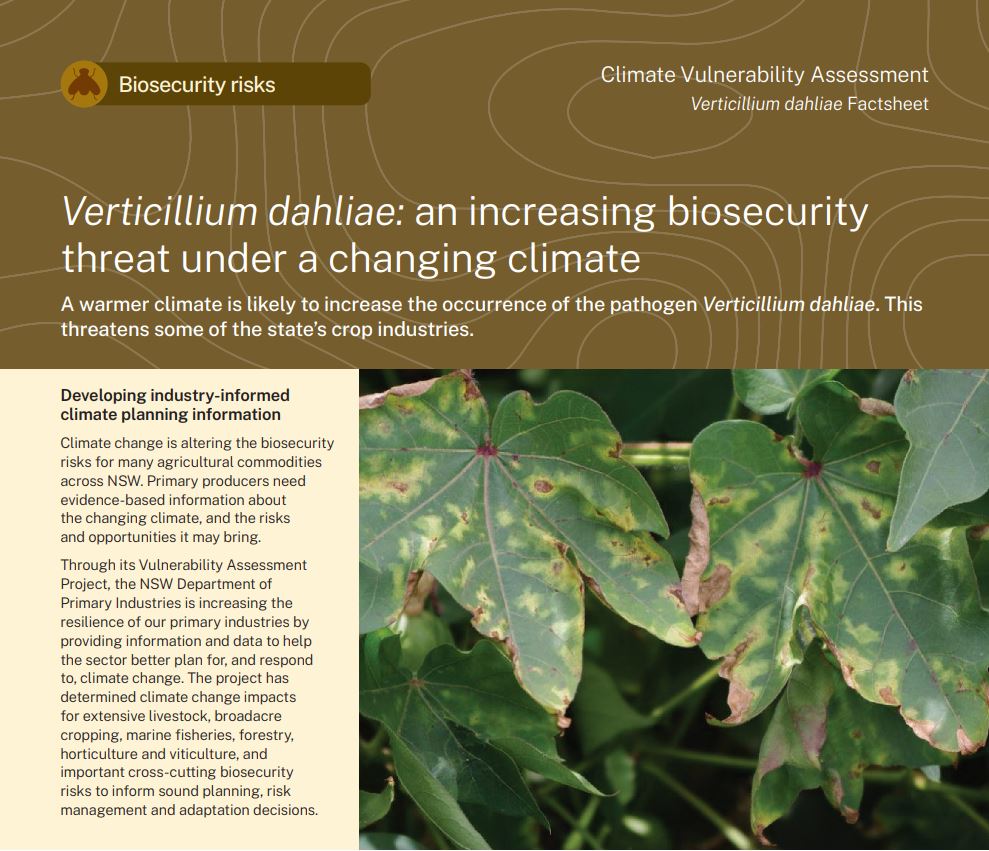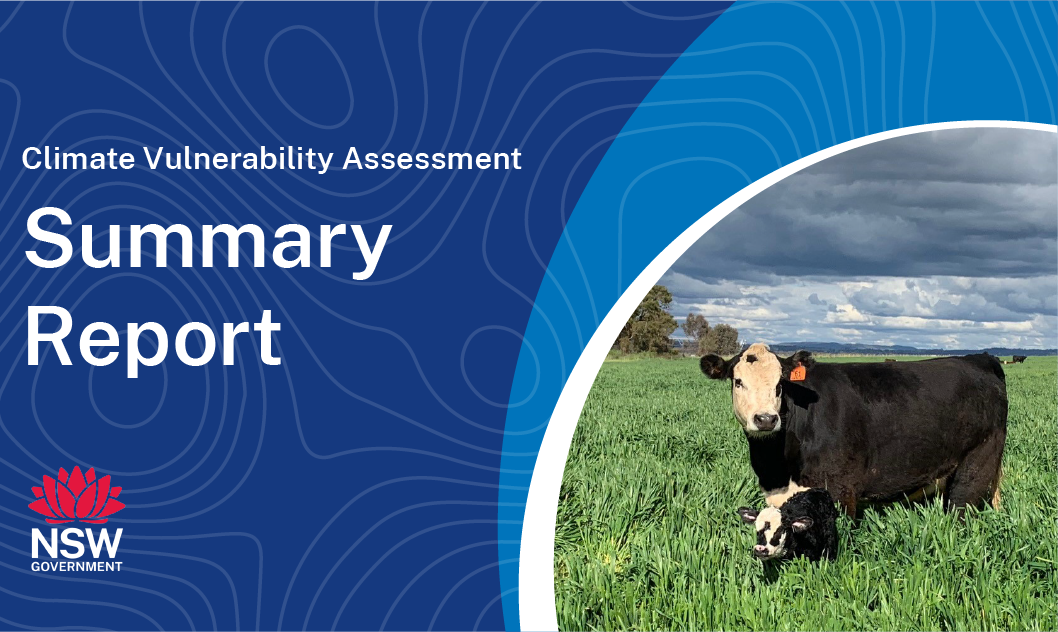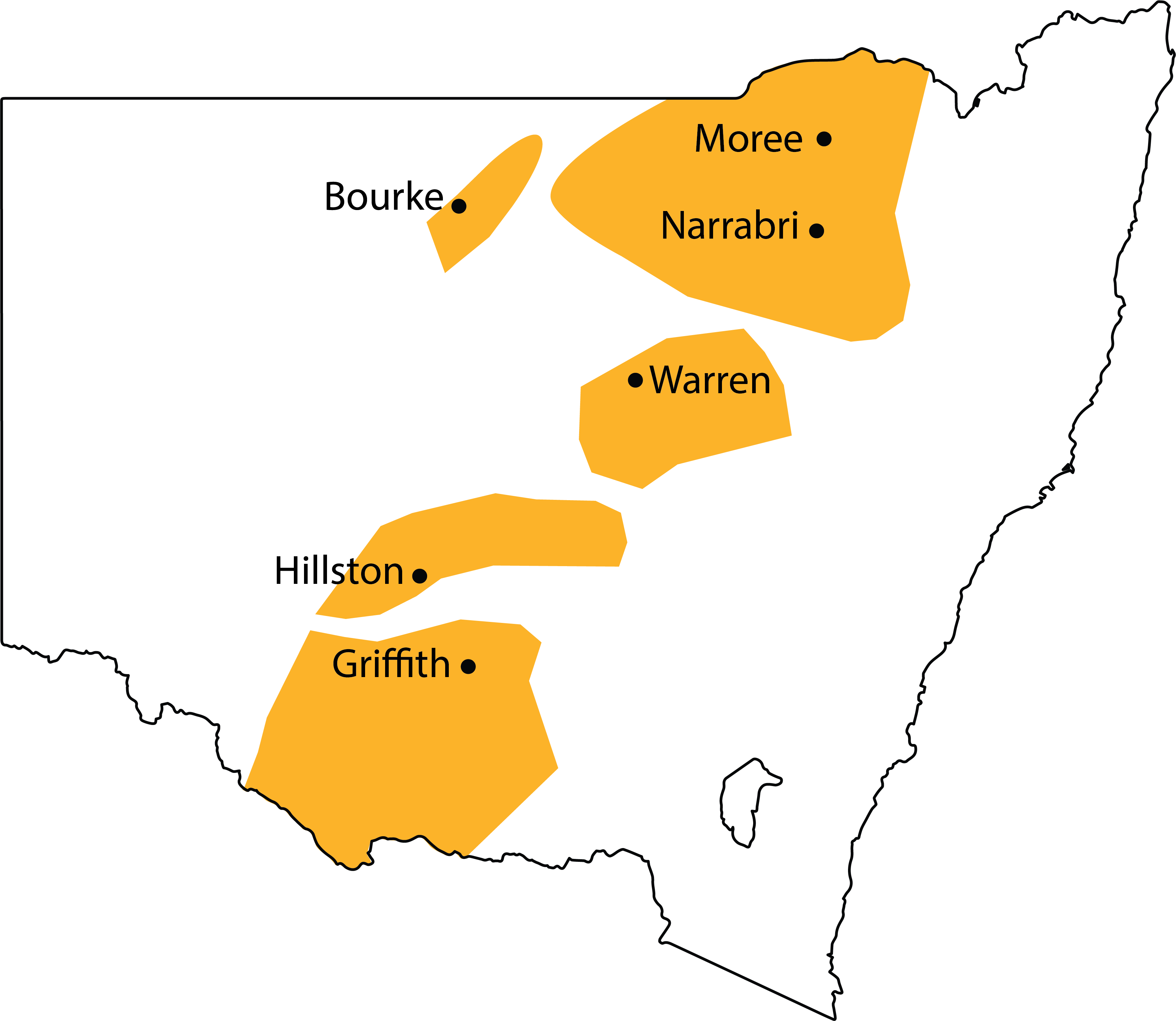What is the NSW DPIRD Climate Vulnerability Assessment? ⏷
Climate change is altering the biosecurity risks for many agricultural commodities across NSW. Primary producers need evidence-based information about the changing climate, and the risks and opportunities it may bring.
The NSW DPIRD Climate Vulnerability Assessments are enhancing the resilience of our primary industries by providing information and data to help the sector better plan for, and respond to, climate change. They have assessed climate change impacts for extensive livestock, broadacre and irrigated cropping, marine fisheries, forestry, horticulture and viticulture, and important biosecurity risks associated with these industries to inform sound planning, risk management and adaptation decisions.
How we assessed climate suitability ⏷
Climate projections were sourced from Climate Change in Australia’s ‘Application Ready Data’. This dataset is comprised of projections from an ensemble of 8 global climate models, each presenting a plausible future climate. Low confidence in the projected changes due to differences between the models is noted in the text. Care should be taken when interpreting these results.
The Climate Vulnerability Assessment is intended to highlight potential industry- or regional-level changes. Intermediate and high emissions scenarios were used in the assessments (RCP4.5 and RCP8.5), but these are not the only future scenarios possible. The inclusion of climate variables important to the commodities production was based on published research, expert knowledge and data quality and availability.
Climate suitability was assessed on a monthly timescale, with the reported climate suitability representing the average for a given month over all years in the dataset. This reflects the pattern of life stages for biosecurity risks and the need to determine which months are likely to pose the greatest risk to host commodities.
Learn more in the Climate Vulnerability Assessment Project Framework.
Climate impacts: expected challenges for primary industries
Changes in climate suitability are likely across key life stages of V. dahliae by 2050, under both emission scenarios.
Changes to monthly climate suitability for the parasitic stage of the defoliating pathotype of V. dahliae are likely to affect Verticillium wilt incidence in NSW in different ways:
- October to April – there are likely to be minimal to moderate increases in climate suitability in all cotton growing regions. The increases are likely to be greatest under the high emissions scenario (moderate to high confidence).
- December – there is likely to be minimal decrease in climate suitability in the Narrabri and Bourke cotton growing regions. The decreases are likely to be greatest under the high emissions scenario (moderate to high confidence).
- May to September – Climate suitability in all cotton growing regions is expected to remain similar to what has been historically experienced under both emissions scenarios (moderate to high confidence).
Changes to monthly climate suitability for the parasitic stage of the non-defoliating pathotype of V. dahliae are likely to affect Verticillium wilt incidence in NSW in different ways:
- December to February – there are likely to be minimal to moderate decreases in climate suitability in all cotton growing regions. The decreases are likely to be greatest under the high emissions scenario (moderate to high confidence).
- March – there are likely to be minimal to moderate decreases in climate suitability in the Narrabri, Bourke and Warren cotton growing regions. The decreases are likely to be greatest under the high emissions scenario (moderate to high confidence).
- April to October – Climate suitability in all cotton growing regions is expected to remain similar to what has been historically experienced under both emissions scenarios (moderate to high confidence).
- November – there are likely to be minimal to moderate decreases in climate suitability in the Narrabri and Bourke cotton growing regions. The decreases are likely to be greatest under the high emissions scenario (low to high confidence).
The effects of Verticillium wilt on the cotton industry in NSW will depend on:
- the future distribution of cotton-growing in NSW,
- changes in production timings, and
- the overlap between susceptible life stages of cotton and the lifecycle of V. dahliae.
Changing climate suitability for V. dahliae under a warmer climate in 2050 may affect Verticillium wilt prevalence in NSW cotton. Cotton in the north of NSW may be particularly affected by 2050, due to the increased climate suitability of the defoliating variant under a warming climate, potentially leading to increased economic losses due to the disease.
Reduced climate suitability for the non-defoliating variant may provide some opportunity for growers in the north of NSW although this may be counteracted by increases in suitability. The occurrence of more suitable climatic conditions during the dormant life stage may increase the risk of the pathogen remaining viable for more than 14 years without a host and developing into the future.
A minimal to moderate increase in suitability may occur across inland NSW in spring, which moves southward towards summer by 2050. This change may pose increased risks for cotton production, as the increase in climate suitability matches planting dates for the southern growing region. Infection of vulnerable early-season plants can cause significant yield loss.
Management practices which can help to reduce losses from the disease include planting resistant varieties, managing crop residues after harvest, rotating susceptible and non-susceptible crops and controlling weeds to prevent the green bridge.
Where can I find the climate suitability maps?
Maps of historical and future climate suitability for commodities were produced to demonstrate where in the state a commodity is likely to thrive or else be limited by future climatic conditions. The maps are not provided on these webpages but can be found in the Climate Vulnerability Assessment Summary Report (PDF, 41425.92 KB).
Verticillium wilt Factsheet
(PDF, 293.66 KB)

Summary Report
(PDF, 41425.92 KB)

 Verticillium wilt in NSW
Verticillium wilt in NSW